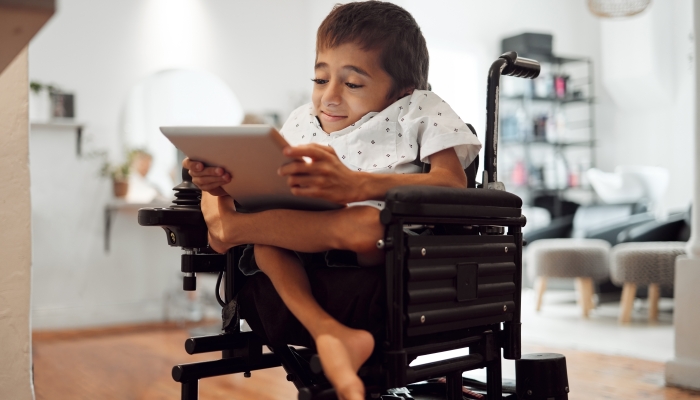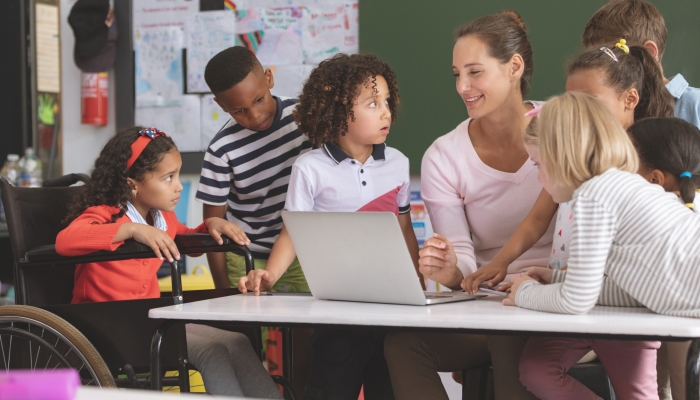5 Ways AI Can Benefit Special Needs Students

- AI-powered tools improve accessibility, transforming how educational content is delivered to students with impairments like dyslexia and visual challenges.
- Adaptive technologies like speech-to-text and text-to-speech encourage independent learning and interaction, providing students with disabilities greater autonomy.
- AI can provide educators with insights through data analysis, helping them understand each student’s unique learning patterns and needs.
- By using AI tools, educators can adapt classroom materials to meet the unique needs of their students, promoting inclusivity and engagement.
The power artificial intelligence can hold in special education is transformational. It isn’t just a tool—it’s a bridge to countless possibilities, offering personalized learning paths, enhancing accessibility, and empowering both special needs students and their educators.
AI in special education classrooms revolutionizes how students with disabilities learn and interact with their environments, ensuring no child is left behind.
Whether you’re a parent seeking better options for your child or an educator aiming to refine your teaching methods, here’s how AI can create opportunities for special needs students and enhance learning outcomes:
1. AI Creates Personalized Learning Paths

AI can improve special education lesson plans by creating individualized education programs.
The algorithms can deeply understand each student’s unique learning patterns, assessing their strengths and weaknesses with impressive precision. This goes beyond spotting what a student is good at or struggles with—these tools can thoroughly map out a journey that adapts to the student’s needs.
These AI-powered tools can be a game changer for students with disabilities who might find the traditional learning pace too rigid.
Platforms like Dreambox Learning or the AI components integrated into Google Classroom can act as lifelines for students who require tailored attention. They adjust in real-time, ensuring that whether a student needs more time to grasp a difficult concept or is ready to move ahead, their educational content always meets these needs.
This not only boosts a student’s learning experience but improves educational outcomes, especially for children with special needs.
2. AI Tools Enhance Accessibility

AI-powered speech-to-text and text-to-speech technologies are revolutionizing accessibility in education, especially for kids with specific challenges like dyslexia, visual impairments, or physical conditions that make it challenging to write.
These AI tools aren’t just add-ons. They transform how students access and engage with educational content.
Text-to-speech software can read text from a digital book aloud, turning what might have been a frustrating experience for a student with dyslexia into an enjoyable educational session.
Similarly, it can help physical or visually impaired students by transcribing their spoken words into written essays or notes, providing a level of independence that was hard to achieve before.
Many apps and other technologies powered by AI also cater to cognitive impairments. One example is AI-driven apps that customize the teaching environment for children with autism by minimizing sensory overload and creating predictable, soothing learning sessions.
Case studies highlight the profound impact of these technologies.
One recently published study11. Hartley, K., Hayak, M., & Ko, U. H.. Artificial Intelligence Supporting Independent Student Learning: An Evaluative Case Study of ChatGPT and Learning to Code. Education Sciences. 2024;14(2), 120. https://doi.org/10.3390/educsci14020120 evaluated the use of ChatGPT in teaching programming skills. The study highlights how AI can facilitate self-regulated learning and provide tailored guidance.
Many other assistive devices and apps also leverage AI technology22. Rice, M.. Examples of Assistive Technology in the Classroom Changing How Education Works. Built In. 2022. https://builtin.com/articles/assistive-technology-in-the-classroom to support students with physical or cognitive impairments.
3. AI Facilitates Communication Skills

AI plays a pivotal role in bridging communication gaps for students who are non-verbal or have speech difficulties. With AI-driven apps, these students can find their voice.
Some AI-powered communication aids can convert symbols and images to speech. There are also tools powered by artificial intelligence that help expand vocabulary, refine grammar, and improve conversational skills.
These technologies allow students to express basic needs and also support more complex interactions. They’re designed to adapt to each student’s pace and style, providing individualized education programs that evolve with their progress.
For students struggling with language-related challenges, like those associated with autism or other learning disabilities, these tools can improve their ability to communicate and, in turn, their quality of life.
This is exactly what a device called Fusion33. Tan Egle, T.. Breaking Through the Silence: How Technology Gave a Voice to My Son. National Federation of the Blind. 2012. https://nfb.org/sites/default/files/images/nfb/publications/fr/fr31/3/fr310310.htm did for Justin, an autistic then-16-year-old with visual impairments. The device, designed specifically for the nonverbal and visually impaired, enabled him to type out words that were then spoken aloud.
In the classrooms of Shawsheen Preschool, a MOVIA robot44. Hughes, M.. Robots Help Pre-K Autistic Learners with Nonverbal Skills. GovTech. 2021. https://www.govtech.com/education/k-12/robots-help-pre-k-autistic-learners-with-nonverbal-skills is also making incredible changes. Four-year-old Roison Connell and other autistic students are learning shapes, colors, and nonverbal communication skills with the help of this AI-powered technology.
These stories illustrate AI’s impact on students with disabilities—transforming them from passive participants in their lives and education to active and engaged individuals capable of expressing their thoughts and needs.
4. AI Enables Inclusive Education Environments

AI breaks down barriers that often separate or isolate students based on their abilities.
Tools powered by AI can help create inclusivity among students with and without special needs by assisting with communication, customizing learning experiences, and creating environments where all students feel understood and supported.
One of the main strategies involves using AI to adapt learning materials and activities to cater to diverse needs. For example, AI systems can modify text complexity based on the reader’s proficiency or alter the presentation of concepts to suit different learning styles.
This proactive approach not only benefits children with disabilities but also improves the learning experience for the entire class by ensuring all students can engage with the learning material at their own level.
In his research paper Exploring the Role of Artificial Intelligence in Inclusive Education55. Dubey, Mr.Chandan. Exploring the Role of Artificial Intelligence in Inclusive Education. Research Gate. 2024. https://www.researchgate.net/publication/378907681_Exploring_the_Role_of_Artificial_Intelligence_in_Inclusive_Education, assistant professor Chandan Kumar Dubey demonstrates how artificial intelligence tools can cater to individual children and create a more equitable learning experience by providing personalized adaptive content and immediate feedback.
By using AI tools, educators can create learning spaces that acknowledge and address all their students’ unique challenges and different needs.
5. AI Empowers Educators with Insights and Resources

AI is not only transforming the student experience but also empowering educators.
A special education teacher can gain actionable insights into each student’s learning patterns and specific needs by leveraging AI analytics. This data-driven approach creates a deeper understanding of what strategies work best for individual students, especially those with special needs.
AI systems can highlight areas where kids excel or struggle, helping special education teachers choose the most effective teaching methods.
AI-driven resources and training tools are also invaluable in supporting special educators when they develop strategies tailored to special education.
These tools provide simulations, scenario-based learning, and real-time feedback, helping teachers refine their approaches and techniques in a supportive, low-risk environment.
One of AI’s most practical educational benefits is its ability to streamline administrative tasks. AI can reduce the time special education teachers spend on paperwork by automating scheduling, grading, and tracking student progress.
This means educators can dedicate more time to what they do best—engaging directly with students. This direct interaction is crucial for children with cognitive and physical disabilities, who often benefit from more personalized attention and interaction.
AI not only informs teachers but also frees up their time so they can be more present, attentive, and creative in their teaching.
The Future of AI for Special Needs Education

The future of AI in special education looks incredibly promising, with multiple improvements on the horizon that could transform the way educational content is delivered66. The Future Of AI In Education Opportunities And Challenges. The Data Scientist. https://thedatascientist.com/the-future-of-ai-in-education-opportunities-and-challenges to students with disabilities even more.
As AI technology evolves, parents and special educators can expect more sophisticated, personalized learning paths that are finely tuned to each student’s needs. This means software will not only adapt to their current abilities but also predict and adjust to their future learning requirements.
Advancements in artificial intelligence tools will also improve accessibility for kids with a range of physical and cognitive challenges. One example is converting classroom materials into accessible formats like Braille or sign language in real-time.
This will help bridge the digital divide and ensure all students have equal access to educational opportunities.
AI is also set to foster more inclusive educational environments. By integrating AI-driven adaptations into traditional classrooms, special education students can more effectively learn alongside their peers, reducing social barriers and promoting a more integrated learning experience.
These technologies not only support children with different needs but also empower educators to manage a more inclusive classroom efficiently.
With AI’s role in education expanding, the possibilities for creating a more equitable and effective learning environment77. Montalvo, E.. 7 AI trends that could reshape education in 2024. Youth Today. 2023. https://youthtoday.org/2023/12/7-artificial-intelligence-trends-that-could-reshape-education-in-2024 for all students are truly exciting.
References
- Hartley, K., Hayak, M., & Ko, U. H. (2024). Artificial Intelligence Supporting Independent Student Learning: An Evaluative Case Study of ChatGPT and Learning to Code. Education Sciences, 14(2), 120. https://doi.org/10.3390/educsci14020120
- Rice, M. (2022, September 27). Examples of Assistive Technology in the Classroom Changing How Education Works. Built In. https://builtin.com/articles/assistive-technology-in-the-classroom
- Tan Egle, T. (2012, Summer). Breaking Through the Silence: How Technology Gave a Voice to My Son. National Federation of the Blind. https://nfb.org/sites/default/files/images/nfb/publications/fr/fr31/3/fr310310.htm
- Hughes, M. (2021, November 23). Robots Help Pre-K Autistic Learners with Nonverbal Skills. GovTech. https://www.govtech.com/education/k-12/robots-help-pre-k-autistic-learners-with-nonverbal-skills
- Dubey, Mr.Chandan. (2024). Exploring the Role of Artificial Intelligence in Inclusive Education. Research Gate. https://www.researchgate.net/publication/378907681_Exploring_the_Role_of_Artificial_Intelligence_in_Inclusive_Education
- The Future Of AI In Education Opportunities And Challenges. The Data Scientist. (n.d.). https://thedatascientist.com/the-future-of-ai-in-education-opportunities-and-challenges
- Montalvo, E. (2023, December 21). 7 AI trends that could reshape education in 2024. Youth Today. https://youthtoday.org/2023/12/7-artificial-intelligence-trends-that-could-reshape-education-in-2024

Related Posts

Eye Conditions and Syndromes, Visual Impairment
Neuralink Announces Plans to Restore Sight to the Blind with Brain Chip
Elon Musk’s company Neuralink has announced plans to begin human trials of its new “Blindsight” brain chip by the end of 2025.

IEPs
What Should I Bring to My Child’s First IEP Meeting?
Prepare for your child's first IEP meeting with confidence! Discover exactly what documents to bring, including educational records, medical info, and questions to ask.

Special Needs
5 Spring Cleaning Tips for Families of Children with Disabilities
Spring cleaning is an opportunity to create a more accessible, organized, and supportive space for your child with disabilities. Declutter, deep clean, and refresh!